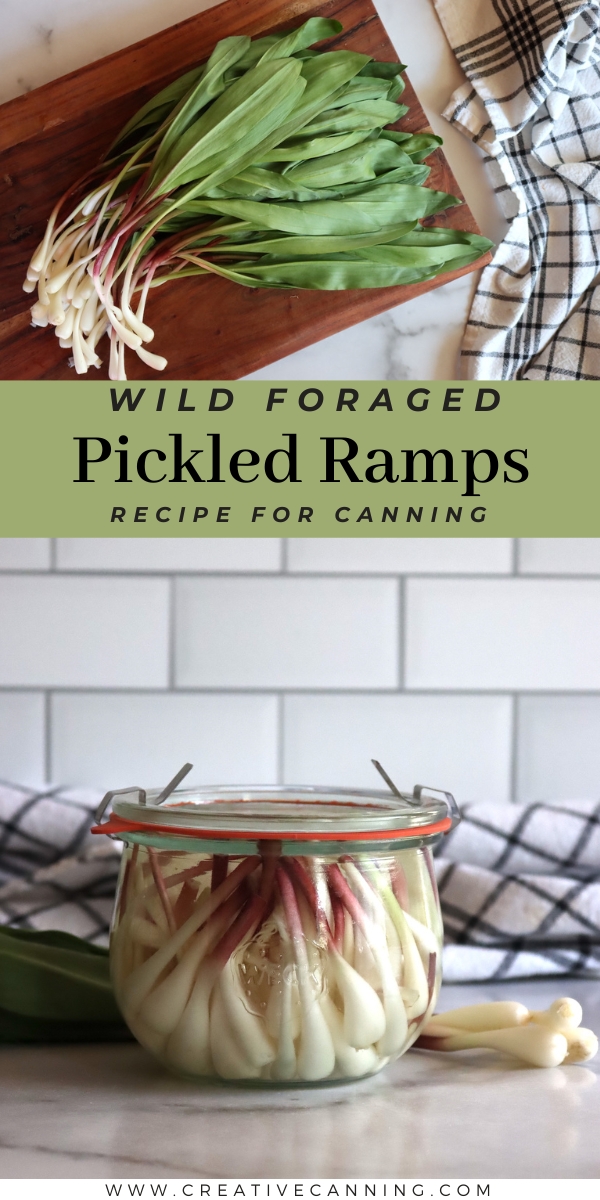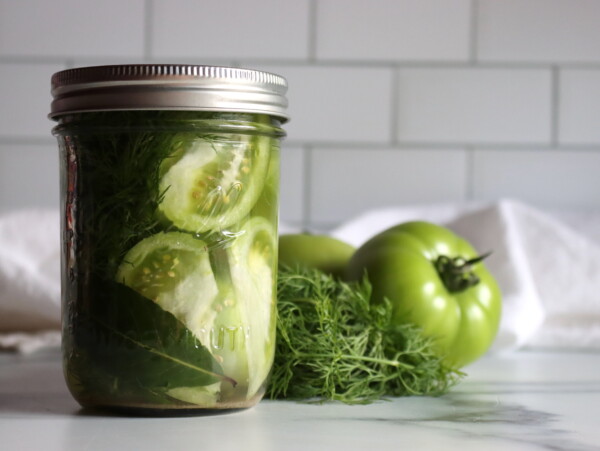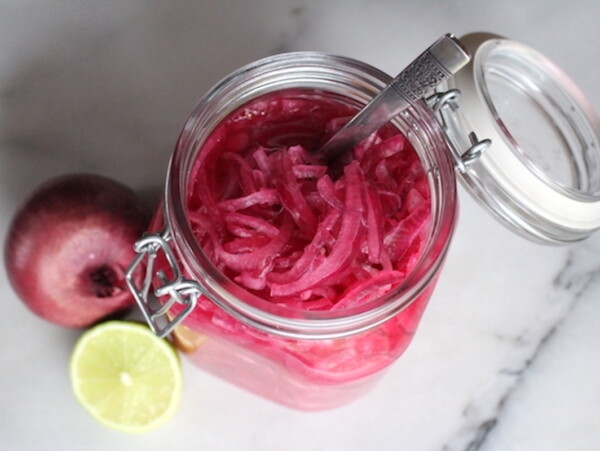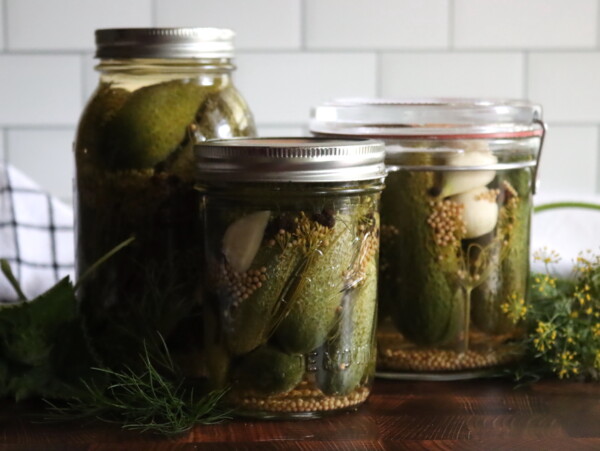This post may contain affiliate links. Please see our disclosure policy.
Pickled ramps are a real treat, and just one or two of these wild foraged beauties can add interest to any meal.

Wild foraged ramps are one of the tastiest things about spring. Whether you forage them yourself or find them at the farmer’s market, pickling ramps is a great way to preserve these flavorful little wild leeks for year-round use.
Adding just a bulb or two later on in the season will bring your mind back to spring, especially during a long winter.
I love these next to hearty winter meals, but they’re equally good with light spring fare.
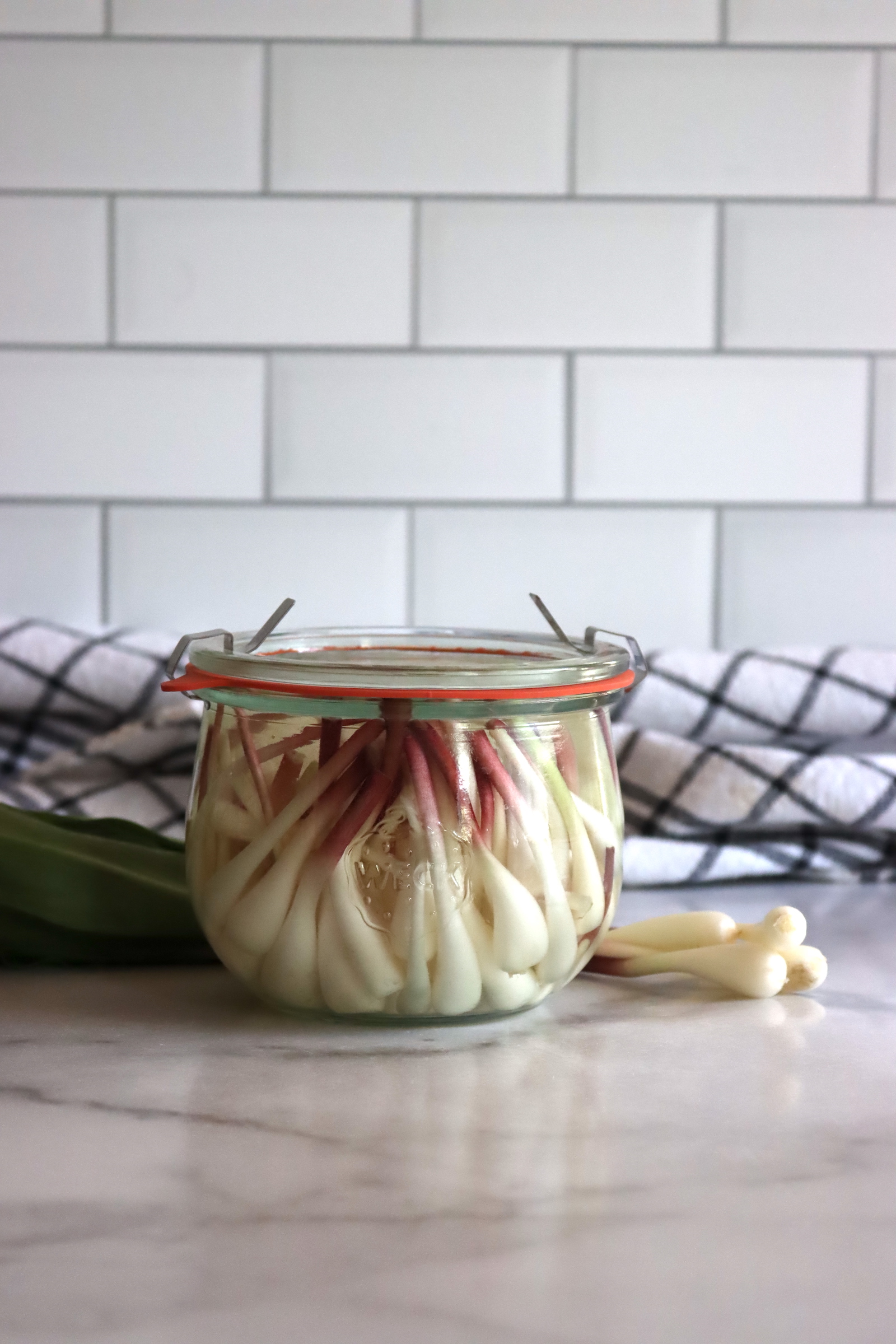
Ingredients for Pickled Ramps
This recipe was adapted from Saving the Season by Kevin West. It follows the principles of safe home canning, namely appropreate canning times for vegetable pickles, and a brine that is made up of at least half vinegar by volume.
To make two half-pint jars of pickled ramps, you will need the following:
- I pound whole ramps, or ½ pound trimmed bulbs (no greens)
- 1 1/4 cup white wine vinegar (5% acidity)
- 3/4 cup water
- 1 Tbsp dry white vermouth (optional)
- 1 Tbsp. sugar
- 1½ teaspoons kosher salt
- 10 black peppercorns
- 1-2 bay leaves
- 3-inch sprig fresh thyme
- 1-inch sprig fresh rosemary
Coarse sea salt or pickling salt are suitable alternatives for kosher salt.
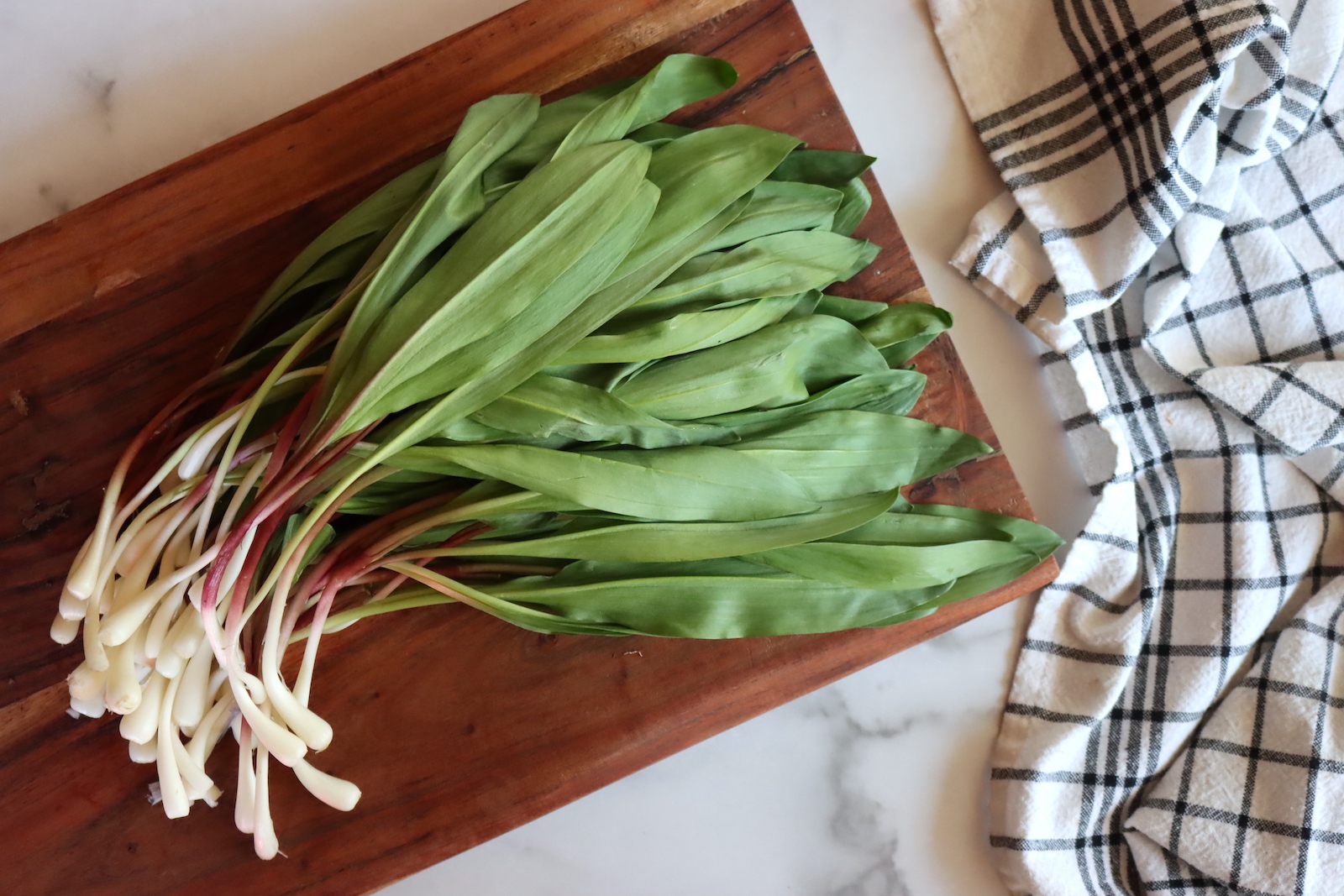
How to Make Pickled Ramps
You may choose to can your pickled ramps in a hot water bath, or they will also last up to one year in your refrigerator, provided you keep them covered in the pickling liquid.
If you are a beginner or are unsure of hot water bath canning, refer to my Beginner’s Guide to Water Bath Canning before proceeding.
Prepare the ramps by cutting off the roots from the bottom of the white bulb (similar to green onion roots).
The outer layer of the ramps may be dry or tough, not looking as white as the inner part of the bulb. If that is the case, peel off only the outer layer so you are left with the white inner bulb.
The green parts of the ramps above the reddish stem are edible, but you will cut them off to make pickled ramps. Keep the greens and use them in other ways, such as you would use chives or green onion tops. They make an exceptional ramp greens pesto, too!
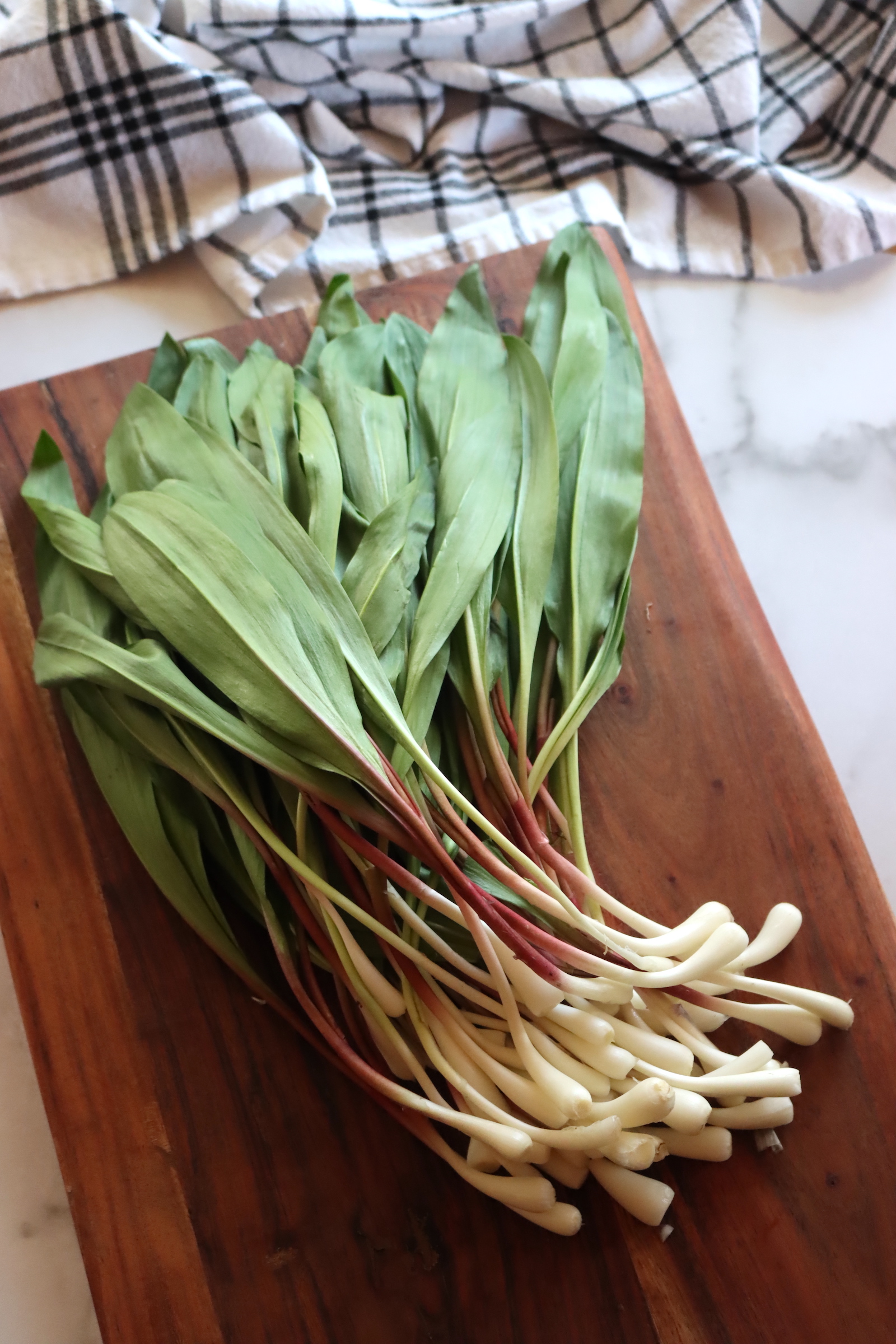
Place the prepared ramps in a medium saucepan or pot. Add the remaining ingredients to the pot and cook over medium-high heat.
Stirring occasionally, bring the mixture to a boil. Reduce the heat to low and simmer the mixture for 5 minutes.
Prepare two half-pint jars by sterilizing them in boiling water.
Using a slotted spoon, pack the hot ramps into the two sterilized jars, and then completely cover them with the boiling pickling liquid, leaving 1/2″ headspace at the top of the jar.
Wipe the rims with a clean, damp cloth and immediately apply 2-part canning lids to the jars.
For refrigerator pickles, allow the jars to sit undisturbed on the counter. The jars should seal as they cool. Once they are cool, store them in the refrigerator for up to one year.
If canning, the next step is to process the jars in a water bath canner.
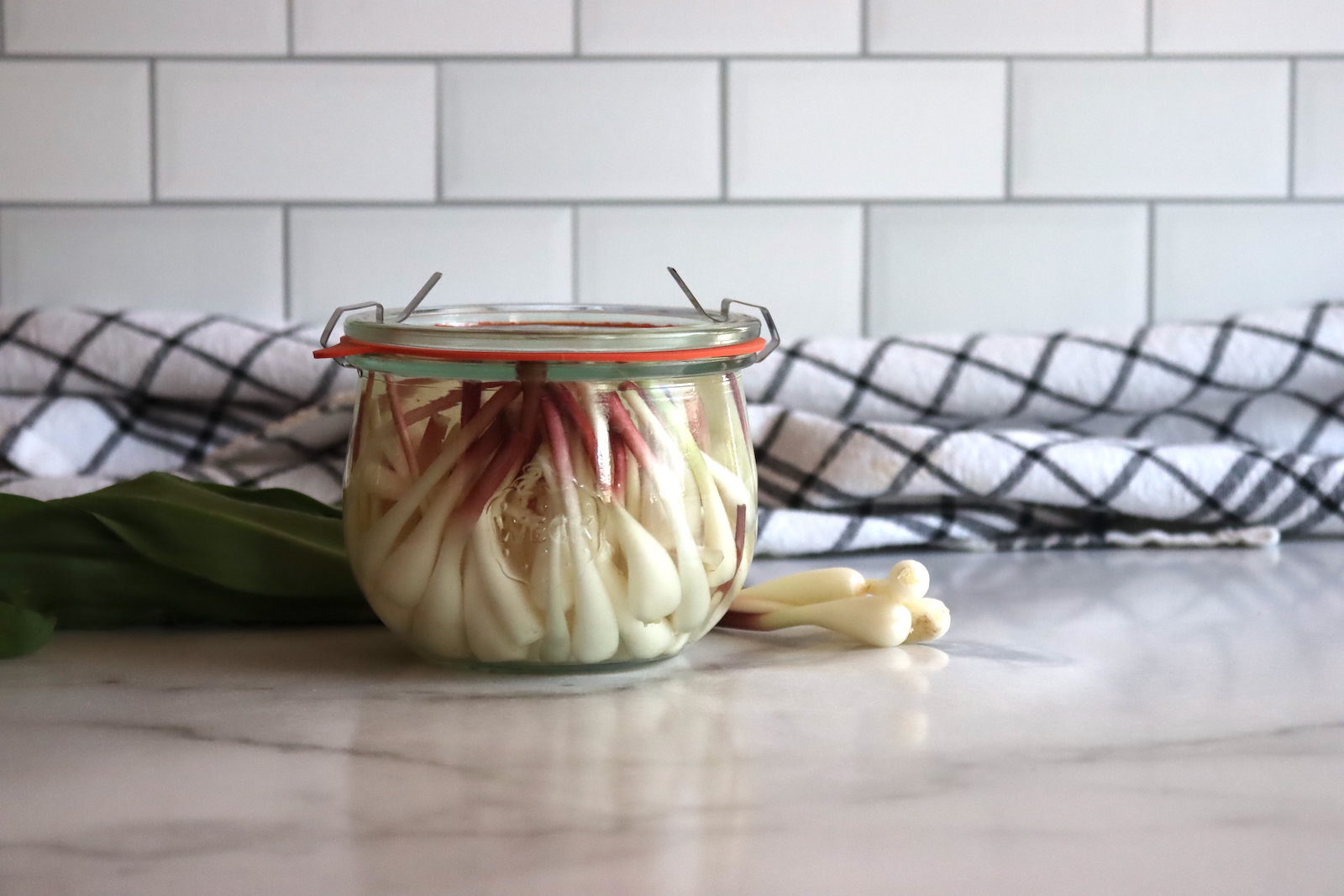
Canning Pickled Ramps
Sterilize canning jars in boiling water, and prepare 2-part canning lids.
Pack the ramps into the hot, prepared jars using a slotted spoon. Then, using a canning funnel, pour the hot pickling liquid over the ramps, leaving 1/2″ headspace at the top.
Wipe the rims of the jars clean using a damp cloth, and attach 2-part canning lids. Do not over-tighten the bands; tighten only to “finger-tight.”
Place the filled jars into the prepared canner with boiling water using a jar lifter, and process the jars for 10 minutes (adjusting for altitude). Ensure the jars are completely covered with water during the entire processing time.
After the processing time is complete, turn off the heat and remove the cover from your canner. Leave the jars in the water for 5 minutes, then use a jar lifter to remove them from the canner and set them to cool on a towel on the counter. Do not tip the jars or wipe excess water off the lids. Let the jars sit undisturbed for at least 12 hours.
Check the jars after 12-24 hours to see if the lids have sealed. Store unsealed jars in the refrigerator.
Store sealed jars in a pantry or cool, dark place for up to 18 months. Refrigerate after opening.
Canning Altitude Adjustments
Water boils at a lower temperature at higher altitudes, so jars need to be processed a bit longer as you go up in elevation. Here are the altitude adjustments for canning ramps:
- For 0 to 1,000 Feet in Elevation – Process pint jars for 10 minutes, and quart jars for 15 minutes.
- For 1,001 to 6,000 Feet in Elevation – Process pint jars for 15 minutes, and quart jars for 20 minutes.
- Above 6,001 Feet in Elevation – Process pint jars for 20 minutes, and quart jars for 25 minutes.
Pickled Ramps Variations
This recipe can also be used to make pickled pearl onions, garlic scapes, or small green garlic.
Other common pickling spices will add a new flavor to your pickled ramps. Try adding red pepper flakes, mustard seed, or cardamom seed.
Using a different vinegar will also change the flavor of your pickled ramps. You can use rice wine vinegar or cider vinegar. Using various vinegars may alter the color of the ramps as they cook and pickle.
Ways to Use Pickled Ramps
Pickled ramps can be served alongside various types of meat, including beef, chicken, pork, and more.
Use pickled ramps when making your favorite sauces and condiments to add a new flavor.
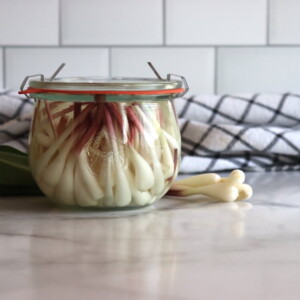
Pickled Ramps (Wild Leeks)
Equipment
Ingredients
- 1 lb whole ramps, or ½ pound trimmed bulbs
- 1 1/4 cup white wine vinegar, 5% acidity
- 3/4 cup water
- 1 Tbsp dry white vermouth
- 1 Tbsp sugar
- 1 ½ tsp kosher salt
- 10 black peppercorns
- 1-2 bay leaves
- 3- inch sprig fresh thyme
- 1- inch sprig fresh rosemary
Instructions
- Prepare the ramps by cutting off the roots from the bottom of the white bulb, and remove the outer layer of the ramp if it is dry or tough. Cut off the green part above the reddish area of the ramp. The green stems may be reserved for other uses.
- Place the prepared ramps into a medium pot or saucepan, and add the remaining ingredients.
- Cook the mixture over medium-high, stirring occasionally, until boiling.
- Reduce heat to low and simmer for 5 minutes.
- Using a slotted spoon, pack the ramps into prepared hot jars.
- Using a canning funnel, pour the hot pickling liquid over the ramps leaving 1/2" headspace at the top of the jars.
- Wipe the rims of the jars with a clean cloth, and apply the 2-part canning lids.
- Allow the jars to sit undisturbed on the counter to cool, and store them in the refrigerator for up to one year.
- You may preserve the pickled ramps using a hot water bath canning method for 10 minutes, adjusting time if necessary for altitude.
- After processing, turn off the heat and leave jars in the canner, uncovered, for 5 minutes. Remove the jars from the canner and let them cool for 12-24 hours, then check that the jars have sealed. Refrigerate any unsealed jars.
- Sealed pickled ramps will retain peak quality for up to 18 months stored in a cool, dry place or pantry. Refrigerate once opened.
Notes
Canning Altitude Adjustments
Water boils at a lower temperature at higher altitudes, so jars need to be processed a bit longer as you go up in elevation. Here are the altitude adjustments for canning pickled ramps:- For 0 to 1,000 Feet in Elevation – Process pint jars for 10 minutes, and quart jars for 15 minutes.
- For 1,001 to 6,000 Feet in Elevation – Process pint jars for 15 minutes, and quart jars for 20 minutes.
- Above 6,001 Feet in Elevation – Process pint jars for 20 minutes, and quart jars for 25 minutes.
Nutrition
Nutrition information is automatically calculated, so should only be used as an approximation.
Vegetable Pickling Recipes
Put up a few more veggies with these vegetable-pickling recipes!
- Pickled Corn Salad
- Pickled Three Bean Salad
- Pickled Green Tomatoes
- Pickled Green Beans (Dilly Beans)
- Pickled Jalapenos
- Pickled Fiddleheads
- Old Fashioned Lime Pickles (Cucumber pickles with pickling lime)
Wild Foraged Canning Recipes
There’s more than one way to put up a little wild-foraged goodness!
- Autumn Olive Jam
- Pin Cherry Jelly
- Wild Grape Jelly
- Aronia Jelly
- Black Locust Flower Jelly
- Saskatoon Jelly
